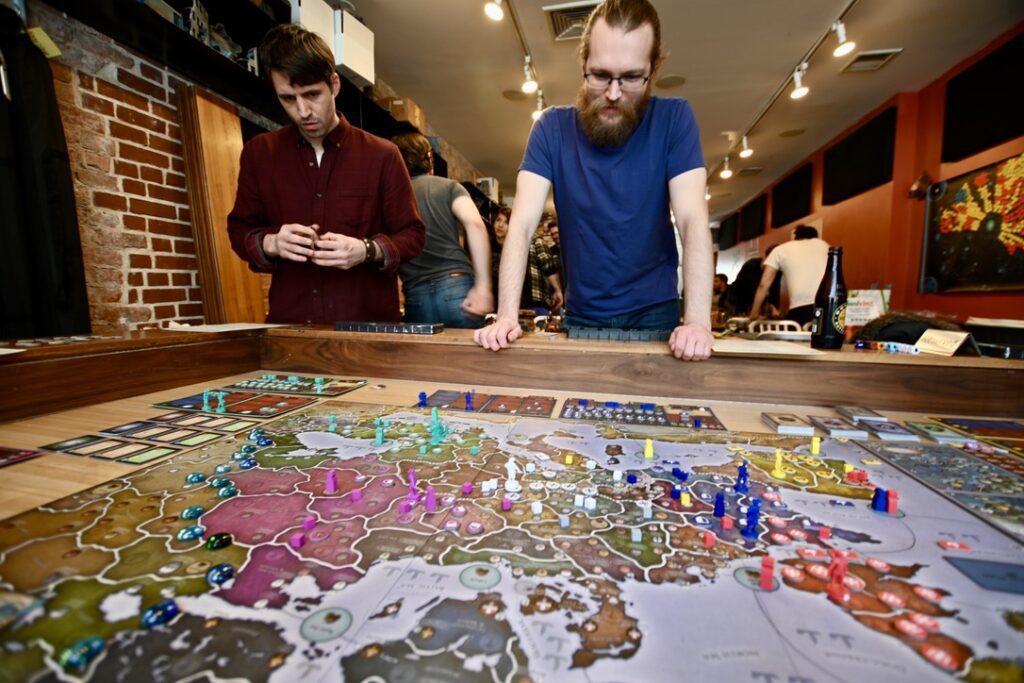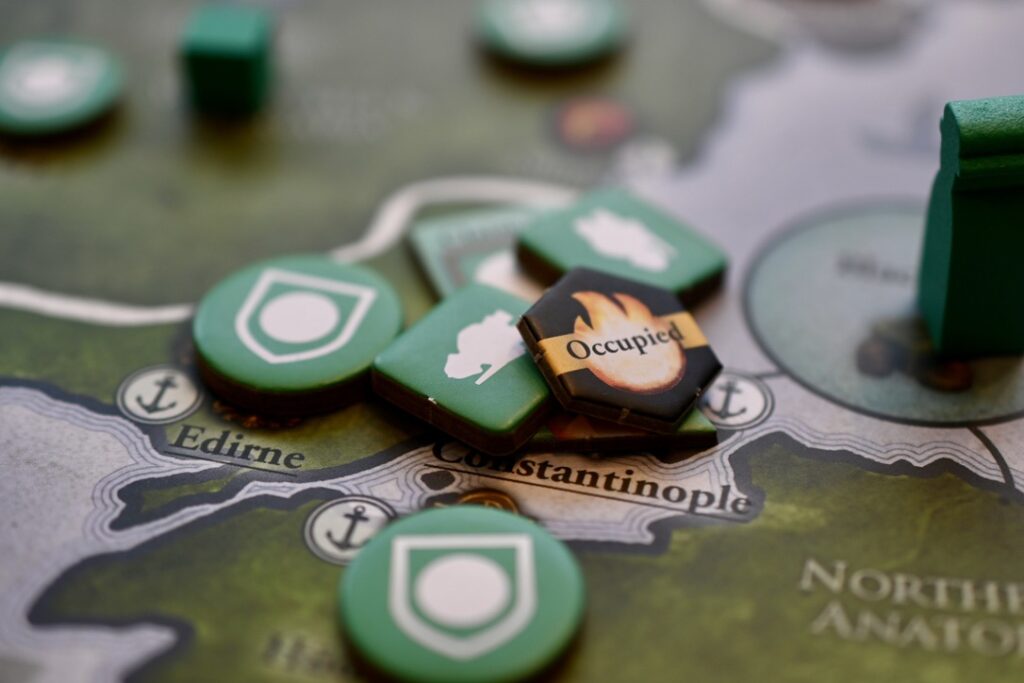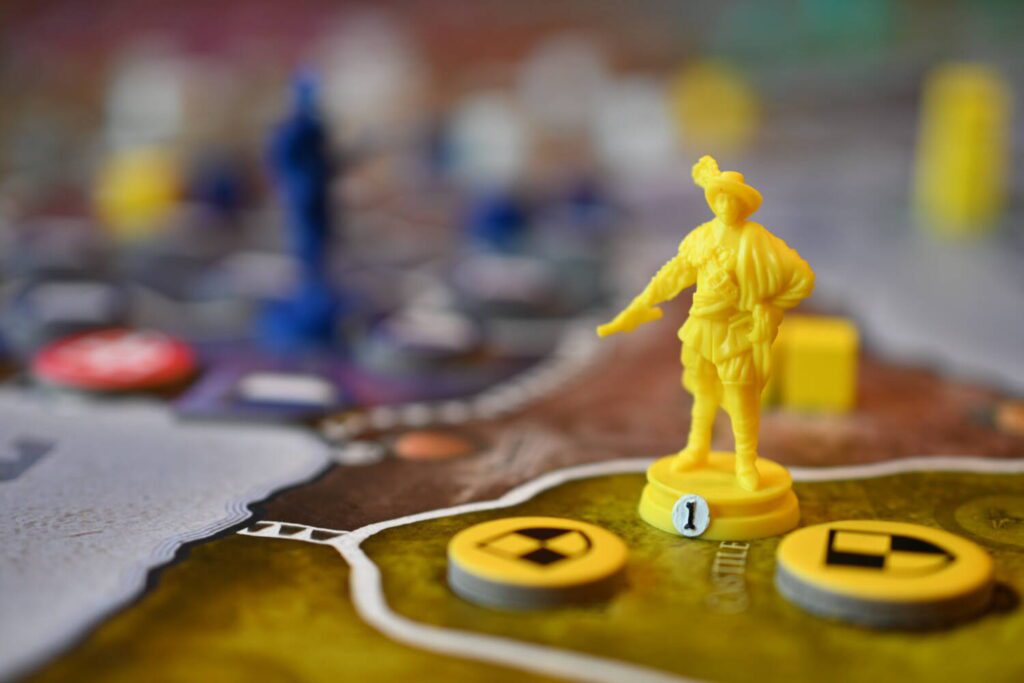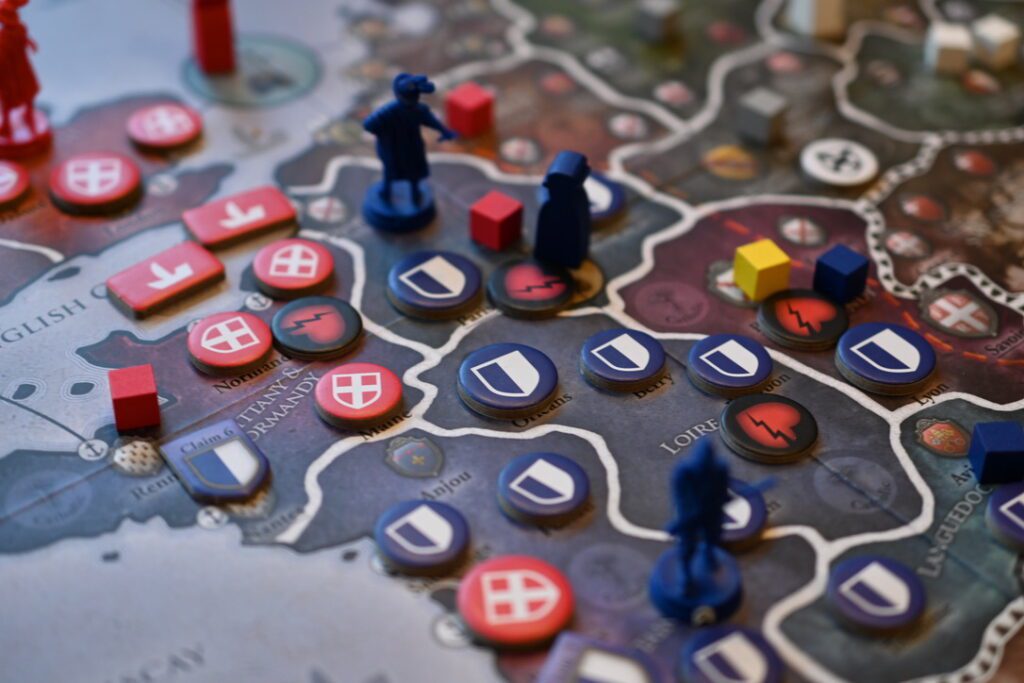Disclosure: Meeple Mountain received a free copy of this product in exchange for an honest, unbiased review. This review is not intended to be an endorsement.
Over the course of several months, I led a group of six players through the Grand Campaign scenario from Europa Universalis: The Price of Power. For 4-6 hours a day, every other Sunday, we would convene around the gaming table, remind ourselves of where we left off, and get to the business of running the great nations of Europe in the 16th century.

All six players were acquainted with Europa Universalis IV (EUIV), the massive computer game that served as source material for this massive board game. Several of them had put thousands of hours into exploring its nooks and crannies. This isn’t, I am told, unusual. EUIV is the type of game that consumes lives. It is one of PC gaming’s largest sandboxes. “I mean, it’s a Paradox game,” people would say over and over, the developer’s name considered enough of an explanation.
The first EU computer game, released back in 2000, was itself adapted from a 1993 board game of the same name. Given that, a modern board game adaptation feels inevitable. It also feels ludicrous. The Price of Power is even more ambitious than that would suggest: this is an attempt to fully adapt EUIV specifically, to grapple with its complexities, its flexibility, its dynamism. That is an act of madness. Hubris packed in a box and sold for around $120, an astonishingly reasonable price point.
What you do during your game depends somewhat on the scenario. There are quite a few of them included with both The Price of Power and its first expansion, The Fate of Empires. Each scenario has a unique setup, uses different portions of the map, promotes different victory conditions, and encourages different styles of play. We chose the Grand Campaign because it is the only scenario (so far) that takes six players, and because it uses just about the entire map. Our players took on the mantles of Castile, France, England, the Holy Roman Empire, Poland, and the Ottoman Empire, vying for total supremacy.

Getting started was rough. When a game has a 48 page rulebook, getting started is always going to be rough. I began setting up about thirty or forty minutes before our scheduled start, and there was still plenty for others to do as they trickled in. Tokens have to be placed. Decks have to be built. Goal cards handed out. Armies placed. Etc, etc. Fortunately, the manual is diligent in explaining how to get everything ready.
About that manual: it is by and large masterful. I expected something impenetrable and dry when I sat down to book up before my first game. Instead, I was met with an enjoyable read. The manual for The Price of Power is clear, concise, and conversational. That’s an achievement for any game, let alone one of this weight. Not only does that make learning the game more enjoyable, the information stuck. A better world is possible.
The first thing we all appreciated once we got started was the turn structure. When a game casts as wide a net as The Price of Power, it always benefits from a straightforward approach to How Things Work. Turn order moves around the table, with each player taking a single action on their turn. Beautiful. There are no action points. You don’t discard cards to pay for other cards. Starting player can change, but the order of play is always the same.

The player aides—essential, practical, well-designed, dog-eared after less than half a game, and yet utterly insufficient to the task of player aiding a game that cannot really be player aided—lay out the structure step-by-step, guiding you through everything. They lay out all the actions, reminding you of what you can do on your turn. I won’t go over all of the actions in depth, but it would be feasible to do so. They make sense. Engage in trade, activate an army to move or attack, play a card, put Influence out onto the board, quash rebels, you get the idea. It’s a surprisingly restricted, surprisingly Euro gamey set of options, but that helps keep things moving. There aren’t that many levers for you to pull, really. There are just an incredible number of places in which you can pull them.
In order to perform an action, you have to have the appropriate amount of Monarch Power, which comes in three flavors: Diplomatic, Administrative, and Military. Diplomatic actions relate to the expansion of your empire. Administrative actions raise income through taxes, deal with religious strife, and so on. Military actions help you get the bastards, whoever the bastards may be at the time. The cubes that represent Monarch Power are refreshed at the start of every round. The amount you get is determined by your current Monarch and your three advisors, which brings us to the cards.
There are three decks of action cards, one in each of the three aforementioned flavors. The first part of each round, players draw three cards in total from the deck(s) of their choice. In this moment, you lay out the general contour of the coming round. Cards are drawn one at a time, and you are under no obligation to declare the next card you’ll draw until you see the first. The cards that you draw broadcast to the table what you hope to accomplish. It’s a subtle but meaningful way for players to interact.
Cards in a game of this scale can be a bit of a sore point, but, crucially, they mostly don’t determine what you can do. Luck of the draw has minimal impact on The Price of Power. There’s even a mechanism for retrieving a card from one of the discard piles. If there is a card you need, you will almost certainly be able to get it.

The bulk of each round is spent in player actions. One action at a time, players weave their tangled webs. I was surprised by how little immediate pressure there is on each individual action, but that isn’t a criticism necessarily. I’ve played War Room, Larry Harris, Jr.’s fabulous WWII design, and one of the primary joys of that game is in every action feeling necessary. If I don’t move into Fiji now, my opponent will, and that’s the ball game. I expected something similar here, but that’s not what The Price of Power is about. It’s more patient than that. The only sense of tradeoff comes from what you can and can’t afford. Time is a luxury. Cash and power are always in short supply.
Before you can pass out of a round—the earlier you pass, the more money you get from the bank—you have to take an Event. Drawn from one of those prepared decks, the Events are how The Price of Power ensures that history keeps on trucking. Hidden away with that deck are plagues, comets, succession crises, and more. Most event cards are split in two, with the player who takes them choosing one of two historical paths forward. Events were when our table most regularly fell to negotiation. “If you take that Event and choose the second path, I’ll leave this territory alone.”
After everyone has passed, you move through a significant period of upkeep. Uprisings break out, treasuries are filled, armies are fed, and power is consolidated. Then you do it all again. Time, truly, is a flat circle.
Over the course of our game, which stretched on for months, the players regularly confessed to thinking about little other than the game. I would come into work—we kept the game within the recess of a massive gaming table—and find one of the players standing over the board, deep in thought. Participants wrote honest-to-god treaties, emailed to the group. The communal love for the game was considerable.

Not to say there weren’t criticisms. A huge part of the joy of EUIV comes from breaking with history. Have Luxembourg successfully invade France, why not? The Price of Power seems to encourage history to more or less play out as it did, at least for the first half of the game. The problem is this: each nation’s deck of private goals steers it in the direction of history, while the public goals encourage the branches on the tree of history to cleave further and further from the trunk. There’s nothing about the presentation of the game to suggest that. The public goals are remote, occupying some hazy corner of the table, while the private goals are right there, in your hand. As a result, we had remarkably little conflict with one another.
Knowing that now, we would all play differently, but this isn’t a quick game. Europa Universalis: The Price of Power is not something you can casually get to the table to try again. That may be the only time most of us ever play. It’s a hard lesson to learn 14 or 15 hours in.
This also ties into a player-voiced issue. As a competitive game, which was admittedly not my biggest focus, the scoring in The Price of Power benefits nations that have easy goals early on. France was bogged down with the plague and internal unrest for an age and a half, and the player wasn’t to blame. There’s not a lot you can do about that. Castille, meanwhile, drowning in money and in control of the papacy, took to the seas and dominated.
I also had issues with the map. The board is fantastic as an object, but as a board? Its use of realism is a good reminder of why board games aren’t usually all that concerned with realism. The map is divided into Areas, which are simple geographic divisions. Each Area contains Provinces, which for the sake of convenience can be thought of as cities. Those Provinces belong to a large assortment of Realms, which may or may not be contained within a single Area.
The Areas and Provinces are easy to see, but the non-player Realms are stickier. They can be spread over a wide area (and several Areas), but the mechanisms for taking them over require complete consolidation. You’ll often miss a Province when considering a Realm, which can have significant impact later on. The whole thing is an interlocking series of gears that don’t ever quite make a flawless machine.

Our game, I should tell you, never reached its conclusion. After two out of four ages, halfway through the game, 20-24 hours deep, we decided to call it. Castile had too much of a lead. Despite Poland’s noble attempt to intercede, declaring war on Castile from across the continent, nothing could be done. That wasn’t all, though. People were tired. Every session was a joy, but the game had lasted too long. The frustrations were compounding, and the players agreed to calling it while we all felt a bit sad about it, rather than waiting until we were over it.
Europa Universalis: The Price of Power is an astonishing achievement. Eivind Vetlesen has accomplished the impossible, and it mostly works. That one man designed this game is almost insulting. It’s certainly not for everybody. The Price of Power is a massive investment of brain space, table space, and time. You have to have the right players, and you have to be okay with playing a game that is occasionally going to fight back. 15 hours deep, I found myself again asking, “Okay, so, how do I declare war on somebody?” Even with an all-time great manual, it’s a lot to take in, and even more to hold onto.

Am I glad I spent 24 hours playing The Price of Power? Yes. I don’t regret it at all. It was a fascinating experience with a wonderful group of people. Was the game worth it? Yeah, I think so. Would I play it again? A shorter scenario, a day game, is something I’d consider. I wouldn’t play The Grand Campaign again, though. I don’t think.
Okay, realistically, it depends on who’s asking.











